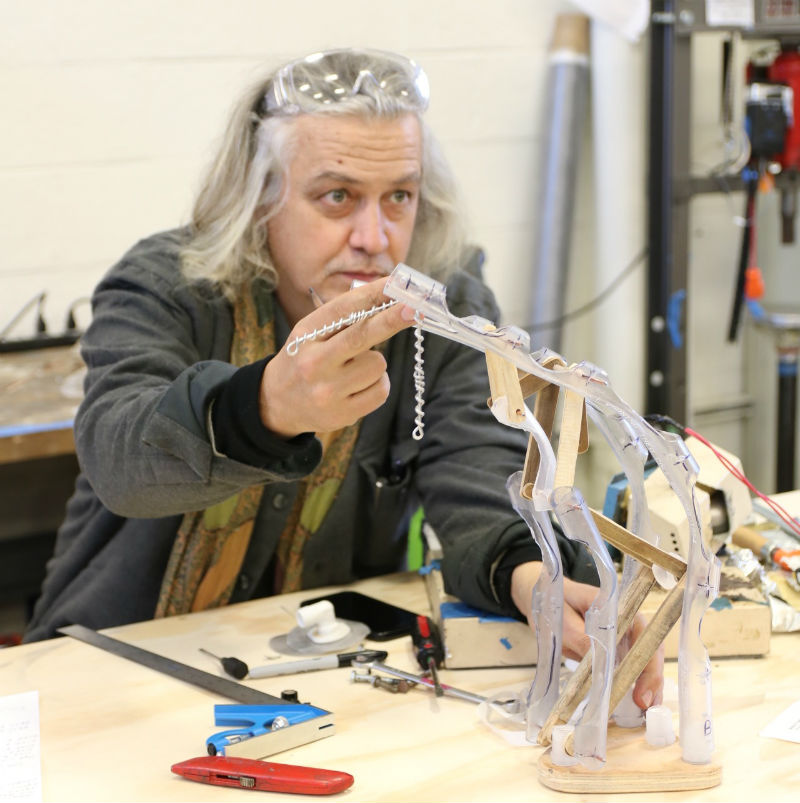"Border Crossers" asks viewers to consider a boundaries-free world in the tech age

Border walls are only as strong as the robot overlords who can smash them to rubble allow them to be.
Sorry, that line was meant for my dystopian sci-fi novel. Chico MacMurtrie's Border Crossers project has a much more positive outlook.
MacMurtrie grew up in the U.S.-Mexico border town of Naco, Ariz., so that uneasy sense of division was almost literally in his backyard. "So much has changed in my lifetime," MacMurtrie said in an interview. "I remember people coming and going across the border through a hole in a fence. The border is now fortified, which is kind of senseless and counter-humane in my opinion."
The artist, who is known for his large-scale robotic sculptures, spent that last semester at the University of Michigan working with 16 students from the art and design, engineering, information, and LSA to build the latest addition to his Border Crossings series.
MacMurtrie is the artistic director of Amorphic Robot Works, an interdisciplinary creative collective in Brooklyn, N.Y. But in his Ann Arbor artist residency, sponsored by the U-M Institute for the Humanities, MacMurtrie and his student assistants have constructed a 40-foot robo-sculpture featuring a lightweight, inflatable, robotic-looking arm on a remote-controlled wheeled bed of electronics. The tube arcs over a wall and touches on the other side to show how, in a modern world filled with tech, borders are navigable obstacles, not permanent barriers.
"I've always envisioned the Mexico-U.S. border as a performance site," MacMurtrie said, "but there are many borders that this artwork could connect. The robots, to me, represent a peaceful gesture to both start a conversation and to unify people."

On Wednesday, Feb. 14, MacMurtrie and his students took one of the robots out for a test drive -- literally as the artist can steer the wheels via remote control -- on U-M's North Campus in front of the Lurie Tower. It was more of a trying-out process for one of the robots rather than an actual demonstration of the Border Crossers sculpture.

But Friday, Feb. 16, promises to be a big day for MacMurtrie and his crew. They'll put the robots on full display with two Border Crossers performances, starting at the U-M Museum of Art at 4:30 pm, which will feature all six robots. MacMurtrie will give a lecture in UMMA's Helmut Stern Auditorium at 5:30, and then give a smaller Border Crossers performance at 6:30 pm on Ingalls Mall in front of Rackham Auditorium. Concurrent with the Ingalls performance is a reception at the nearby U-M Institute for the Humanities.
The robot overlords will be happy to see you there.
Christopher Porter is a library technician and the editor of Pulp.
The "Border Crossers" exhibition runs Feb. 16-Mar. 23 at U-M's Institute for the Humanities Gallery, 202 S. Thayer St., Ann Arbor. Gallery hours are Monday-Friday 9 am-5 pm. The live robotic performances are on Friday, Feb. 16 -- first at the U-M Museum of Art (525 S. State St.) at 4:30 pm and then at the Ingalls Mall at 6:30 pm. Artist Chico MacMurtrie will talk about his robotic sculpture in a Penny Stamps Lecture at 5:30 pm on Friday, Feb. 16, in UMMA's Helmut Stern Auditorium. A reception for the artist will be held at 6:30 pm at the Institute for the Humanities. All the events are free. Visit lsa.umich.edu for more info.


































